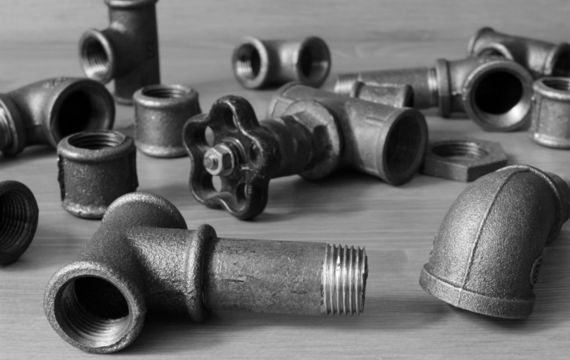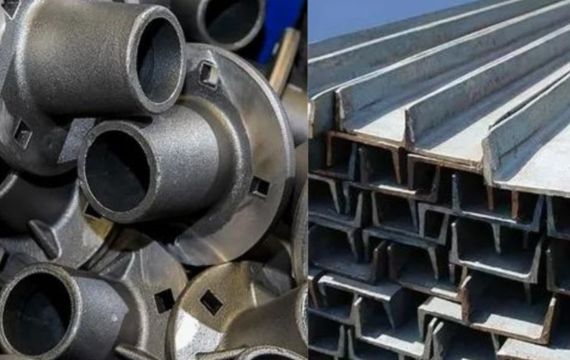How to Identify Cast Iron vs Steel?
Many manufacturers employ metals like steel and iron because of their strength, resilience, and enduring shine. Making the right material choice for your product is the first step in employing the proper technique, as different types of metal serve different functions.
Cast Iron: What Is It?
Iron is created by melting alloys made of iron and carbon. Usually, this alloy has between 2 and 4% carbon. It is important to note that the cast iron has more carbon than 2%. Moreover, instead of working with molten iron using a hammer and other instruments, ironsmiths pour it into a mold.
Different processing techniques and heat treatments used during the manufacturing process have resulted in different variants of this brittle material. Among the several types of cast iron are:
- Malleable Iron
- Gray Iron
- White Iron
- Ductile Iron
- Compacted Iron Graphite


Steel: What Is It?
Steel is an iron alloy that contains traces of carbon, typically between 0.15 and 2%. Steel becomes more robust and resistant to breaking because of the carbon content. Other elements including silicon, manganese, phosphorus, sulfur, and oxygen might also be present, which could improve its properties.
There are several kinds of steel. They consist of:
- Steel Carbon
- Steel Alloy
- Stainless steel
- Steel Tool
Cast Iron: Uses
Grey, white, ductile, and malleable iron are several subtypes of cast iron. Each variety focuses on enhancing particular qualities for a particular function. Though there are many noteworthy applications for cast iron, these are just a few:
- Cookware pan made of cast iron, such as skillets.
- Various parts, including brake disks and engine blocks for automobiles.
- Fencing, fireplaces, ornamental light fixtures, and other decorations for private homes.
- Manhole covers, fittings, and valves used in sewage and water systems.
- Gears, shafts, linkages, chains, and other parts.


Steel: Uses
Although steel products can be forged, rolled, or cast, cast steel is mostly employed in the following applications:
- Rail car bolsters, frames, and wheels
- Heavy vehicles, construction gear, and mining equipment
- Sturdy fittings, valves, pipe, and pumps
- Engine blocks, turbochargers, and additional car parts
- Power plant assemblies’ turbines and other parts
What Are the Differences Between Steel and Cast Iron?


Carbon Content
- Cast iron: Between 2% and 4%
- Steel: Around 2%
Melting Point
- Cast Iron: 2200 degrees Celsius
- Steel: 2500–2800 degrees Celsius
Strength
- Cast Iron: Increased compressive strength
- Steel: Increased tensile strength
Castability
- Cast Iron: Low shrinkage and good flowability make it easy to cast.
- Steel: Less pliable to cast than cast iron due to increased shrinkage and poor flowability.
Corrosion Resistance
- Cast Iron: Extra resistant to rust
- Steel: Not quite as robust as iron
Impact Resistance
- Cast Iron: More resilient to impacts
- Steel: Less resilient to impacts
Cost
- Cast Iron: More affordable since less energy, labor, in order to create the final product, and supplies.
- Steel: More costly than cast iron, despite less expensive options such as prefabricated steel shapes such as beams, tubes, bars, and rods.
Cast Iron Vs Steel Advantages and Disadvantages

Cast Iron Advantages
- Capable of casting
- Extreme toughness
- Its strength under compression is high
- Cast irons may be machined easily.
- Strong anti-vibration qualities
- Its wear resistance is outstanding
- Focus under low stress
- Strong resistance to bending
- Easily obtained in bulk, which lowers the cost of manufacture
Cast Iron Disadvantages
- Easily rusted and corroded
- Insufficient tensile power
- Resistance to impacts well
- Overly delicate
- Excessive weight-to-strength ratio

Steel Advantages
- Enhanced fortitude
- Corrosion-resistant
- Simple to machine
- More creative freedom because you can select whatever alloy element to use with steel.
Steel Disadvantages
- More costly than cast iron
- Not as resilient to impact
Cast Iron Vs Steel: Which One to Choose?
In most cases and settings, using steel is more cost-effective and durable than using iron since it is stronger, lighter, and more durable.
However, iron can be easily molded and formed since it is more ductile than steel.
The qualities and applications needed for your project will determine which of these two metals is best.
What’s More Durable, Cast Iron or Steel?
Material strengths vary from one another.
But compared to cast iron, steel is more robust. And also cast iron has a higher strength than steel.
Which is Heavier, Steel or Cast Iron?
Generally speaking, cast iron weighs more than steel.
Cast iron has more substance because of its composition, which gives it a higher density.



